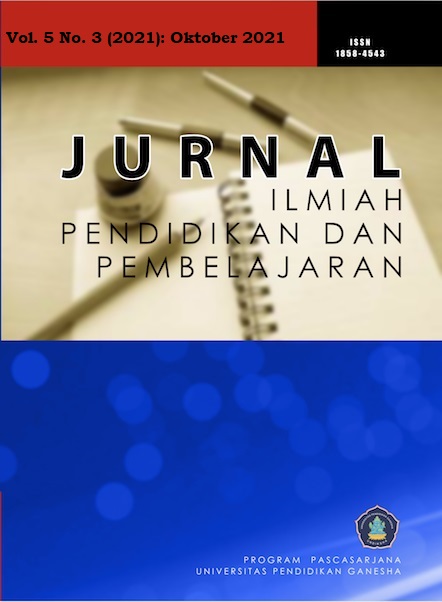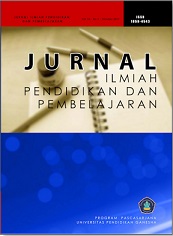Criteria Affecting Readiness Entering the World of Work in Vocational School Students
DOI:
https://doi.org/10.23887/jipp.v5i3.38618Kata Kunci:
prakerin, discipline, work motivation, readiness to enter the world of workAbstrak
Salah satu permasalahan terkait kualitas lulusan SMK adalah ketidaksiapan siswa memasuki Dunia Usaha/Dunia Kerja (DU/DI). Ketidaksiapan lulusan SMK dalam melakukan pekerjaan di dunia kerja berdampak pada industri pengguna tenaga kerja karena industri harus memberikan pendidikan di dalam industri untuk mempersiapkan tenaga kerja. Penelitian ini bertujuan untuk menganalisis hubungan antara pelaksanaan praktik kerja industri (Prakerin), disiplin, dan motivasi kerja terhadap kesiapan memasuki dunia kerja. Jenis penelitian ini adalah kuantitatif dengan metode penelitian korelasional. Populasi dalam penelitian ini adalah seluruh siswa kelas berjumlah 75 siswa. Teknik pengambilan sampel yang digunakan adalah total sampling, yaitu teknik pengambilan sampel, jumlah sampel sama dengan populasi 75 siswa. Analisis data dilakukan dengan uji normalitas, uji linieritas, dan uji hipotesis. Berdasarkan analisis data uji menunjukkan bahwa data tersebut normal dan linier. Hasil pengujian nilai Fhitung sebesar 65,553 dengan Ftabel 2,731 karena Fhitung > Ftabel. Itu berarti terdapat hubungan antara pelaksanaan praktik kerja industri, disiplin, dan motivasi terhadap kesiapan memasuki dunia kerja. Jadi, dapat disimpulkan bahwa kesiapan dan motivasi kerja siswa untuk memasuki dunia kerja sangat penting.
Referensi
Adjii, K. (2019). Instrumen Penilaian Kedisiplinan Siswa Sekolah Menengah Kejuruan. Assessment and Research on Education, 1(1). https://doi.org/10.33292/arisen.v1i1.19.
Ahad, R., Mustafa, M. Z., Mohamad, S., Abdullah, N. H. S., & Nordin, M. N. (2021). Work Attitude, Organizational Commitment, and Emotional Intelligence of Malaysian Vocational College Teachers. Journal of Technical Education and Training, 13(1), 15–21. https://doi.org/10.30880/jtet.2021.13.01.002.
Andriani, R., & Rasto, R. (2019). Motivasi Belajar sebagai Determinan Hasil Belajar Siswa. Jurnal Pendidikan Manajemen Perkantoran, 4(1), 80. https://doi.org/10.17509/jpm.v4i1.14958.
Ashari, H., Abdal, N. M., & Setialaksana, W. (2021). Pengembangan Model Link and Match Melalui Praktek Kerja Industri (Prakerin) Jurusan Teknik Tenaga Listrik. Jurnal Media Elektrik, 18(1), 8–13. https://doi.org/10.26858/metrik.v18i1.19407.
Ayuni, D., Marini, T., Fauziddin, M., & Pahrul, Y. (2021). Kesiapan Guru TK Menghadapi Pembelajaran Daring Masa Pandemi Covid-19. Jurnal Obsesi : Jurnal Pendidikan Anak Usia Dini, 5(1). https://doi.org/10.31004/obsesi.v5i1.579.
Borthwick, A. C., & Hansen, R. (2017). Digital Literacy in Teacher Education: Are Teacher Educators Competent? Journal of Digital Learning in Teacher Education, 33(2), 46–48. https://doi.org/10.1080/21532974.2017.1291249.
Bustanil S, M., Asrowi, & Adianto, D. T. (2019). Pengembangan Media Pembelajaran Interaktif Berbasis Video Tutorial di Sekolah Menengah Kejuruan. JTP - Jurnal Teknologi Pendidikan, 21(2), 119–134. https://doi.org/10.21009/jtp.v21i2.11568.
Choi, S. J., Jeong, J. C., & Kim, S. N. (2019). Impact of Vocational Education and Training on Adult Skills and Employment: An Applied Multilevel Analysis. International Journal of Educational Development, 66(12), 129–138. https://doi.org/10.1016/j.ijedudev.2018.09.007.
Disas, E. P. (2018). Link and Match sebagai Kebijakan Pendidikan Kejuruan. Jurnal Penelitian Pendidikan, 18(2), 231–242. https://doi.org/10.17509/jpp.v18i2.12965.
Effendi. (2017). Hubungan Readiness (Kesiapan) Belajar Siswa dengan Hasil Belajar Fisika Kelas X SMK Muhammadiyah 03 Sukaraja. Jurnal Pendidikan Fisika (JPF), 5(1), 15–24. https://doi.org/10.24127/jpf.v5i1.740.
Ferdian, A., Maryam, S., & Selamat, I. N. (2018). Analisis Kesiapan Belajar Siswa Kelas X MIPA dalam Pembelajaran Kimia. Jurnal Pendidikan Kimia Undiksha, 2(1), 8. https://doi.org/10.23887/jjpk.v2i1.21177.
Gohae, A. S. (2020). Pengalaman Magang, Minat Kerja, dan Pengaruhnya terhadap Kesiapan Kerja Mahasiswa Akuntansi. Jurnal Ilmiah MEA, 4(3), 1954–1964. https://doi.org/10.31955/mea.vol4.iss3.pp1954-1964.
Hakim, A. R. & M. (2020). Pengaruh Motivasi Kerja dan Kompensasi terhadap Kepuasan Kerja Guru SMK Swasta di Wilayah Timur Kabupaten Pemalang. Jurnal Pendidikan Ilmu Sosial, 29(2), 105–115. https://doi.org/10.23917/jpis.v29i2.9354.
Jayadiningrat, M. G. (2017). Meningkatkan Kesiapan dan Hasil Belajar Siswa pada Pembelajaran Kimia dengan Pemberian Kuis di Awal Pembelajaran. E-Journal Pendidikan Kimia Indonesia, 1(1), 7–12. https://doi.org/10.23887/jpk.v1i1.12806.
Koswara, K., & Rasto, R. (2016). Kompetensi dan Kinerja Guru Berdasarkan Sertifikasi Profesi. Jurnal Pendidikan Manajemen Perkantoran, 1(1), 61. https://doi.org/10.17509/jpm.v1i1.3269.
Kratz, F., Patzina, A., Kleinert, C., & Dietrich, H. (2019). Vocational Education and Employment: Explaining Cohort Variations in Life Course Patterns. Social Inclusion, 7(3), 224–253. https://doi.org/10.17645/si.v7i3.2045.
Kuper, H. (2020). Industry 4.0: Changes in Work Organization and Qualification Requirements—Challenges for Academic and Vocational Education. Entrepreneurship Education, 3(2), 119–131. https://doi.org/10.1007/s41959-020-00029-1.
Kurniawan, F. Y., Siahaan, S. M., & Hartono, H. (2020). Pengembangan Multimedia Interaktif Berbasis Adventure Game pada Materi Prinsip Animasi. Jurnal Inovasi Teknologi Pendidikan, 6(2), 183–195. https://doi.org/10.21831/jitp.v6i2.28488.
Kusumaningtyas, A., & Setyawafi, E. (2015). Teacher Performance of the State Vocational High School Teachers in Surabaya. International Journal of Evaluation and Research in Education (IJERE), 4(2), 76–83. https://doi.org/10.11591/ijere.v4i2.4495.
Lase, D. (2019). Education and Industrial Revolution 4.0. Handayani Journal PGSD FIP Unimed, 10(1), 48–62. https://doi.org/10.24114/jh.v10i1.14138.
Mason, G. (2020). Higher Education, Initial Vocational Education, and Training and Continuing Education And Training: Where Should The Balance Lie? Journal of Education and Work, 33(7–8), 468–490. https://doi.org/10.1080/13639080.2020.1755428.
Mulyani, D. (2013). Hubungan Kesiapan Belajar Siswa dengan Prestasi Belajar. Konselor, 2(1), 27–31. https://doi.org/10.24036/0201321729-0-00.
Nurtanto, M., Kholifah, N., Masek, A., Sudira, P., & Samsudin, A. (2021). Crucial Problems in Arranged the Lesson Plan of Vocational Teacher. International Journal of Evaluation and Research in Education (IJERE), 10(1), 345–354. https://doi.org/10.11591/ijere.v10i1.20604.
Okai-Ugbaje, S., Ardzejewska, K., & Imran, A. (2020). Readiness, Roles, and Responsibilities of Stakeholders for Sustainable Mobile Learning Adoption in Higher Education. Education Sciences, 10(3), 1–21. https://doi.org/10.3390/educsci10030049.
Oswald-Egg, M. E., & Renold, U. (2021). No Experience, No Employment: The Effect of Vocational Education and Training Work Experience n Labour Market Outcomes After Higher Education. Economics of Education Review, 60. https://doi.org/10.1016/j.econedurev.2020.102065.
Paramitha, I. D. A. A., Sulastri, M. P., & Margunayasa, I. G. (2016). Pengaruh Model Inkuiri Terbimbing, Gaya Kognitif, dan Motivasi Berprestasi terhadap Pemahaman Konsep IPA Siswa Kelas V SD. MIMBAR PGSD Undiksha, 4(1), 1–11. https://doi.org/10.23887/jppundiksha.v49i2.9012.
Pratama, S. A., Winanti, E. T., & Wardhono, A. (2019). Profile of 3 Years and 4 Years Vocational School Relationship with the Preparation of Graduates Building Engineering Expertise Program. International Journal for Educational and Vocational Studies, 1(6), 623–626. https://doi.org/10.29103/ijevs.v1i6.1787.
Purnamasari, D. (2018). Pengaruh Lingkungan Kerja dan Disiplin Kerja terhadap Kepuasan Kerja Guru Sekolah Menengah Kejuruan (SMK) Swasta Sekecamatan Pondok Aren. Jurnal Saintika Unpam : Jurnal Sains dan Matematika Unpam, 1(1), 108. https://doi.org/10.32493/jsmu.v1i1.1607.
Puspitorini, Subali, & Jumadi. (2014). Penggunaan Media Komik dalam Pembelajaran IPA untuk Meningkatkan Motivasi dan Hasil Belajar Kognitif dan Afektif. Cakrawala Pendidikan, 33(3), 413–420.
Qureshi, M. I., Khan, N., Raza, H., Imran, A., & Ismail, F. (2021). Digital Technologies in Education 4.0. Does it Enhance the Effectiveness of Learning? A Systematic Literature Review. International Journal of Interactive Mobile Technologies (IJIM), 15(04), 31–47. https://doi.org/10.3991/ijim.v15i04.20291.
Rahmah, L., & Muslim, S. (2019). Implementation of Competence Certification Test for the Improvement of Vocational School of Work Graduation Readiness. 1st Vocational Education International Conference, 231–237. https://doi.org/10.2991/assehr.k.191217.038.
Risnawati, A., & Nuraeni, L. (2019). Meningkatkan Kemampuan Berbahasa Sunda Anak Usia Dini Melalui Kegiatan Rebo Nyunda di Pendidikan Anak Usia Dini. CERIA (Cerdas Energik Responsif Inovatif Adaptif), 2(5). https://doi.org/10.22460/ceria.v2i5.p243-250.
Samidjo, S. (2017). Efektifitas Pelaksanaan Magang Industri Mahasiswa Program Studi Pendidikan Teknik Mesin. Taman Vokasi, 2(2), 246. https://doi.org/10.30738/jtvok.v5i2.2528.
Sariwulan, T., Widodo, Perdana, N. S., Fajarini, & Agung, I. (2020). The Influence of Absorption Graduates Vocational Education: A Case Study. Academic Journal of Interdisciplinary Studies, 9(2), 55–71. https://doi.org/10.36941/ajis-2020-0023.
Soucie, J., Vandervoort, L., Adkins, L. E., & Miller, S. (2021). Experiential Education for the Deaf or Hard of Hearing Learner in a Pharmacy Curriculum. Currents in Pharmacy Teaching and Learning, 13(9). https://doi.org/10.1016/j.cptl.2021.06.025.
Stellmacher, A., Ohlemann, S., Pfetsch, J., & Ittel, A. (2020). Pre-service Teacher Career Choice Motivation: A Comparison of Vocational Education and Training Teachers and Comprehensive School Teachers in Germany. International Journal for Research in Vocational Education and Training, 7(2), 214–236. https://doi.org/10.13152/IJRVET.7.2.5.
Sugiyono. (2018). Metode Penelitian Pendidikan Pendekatan Kuantitatif, Kualitatif dan R&D. Alfa Beta.
Sukanti, S. (2011). Penilaian Afektif dalam Pembelajaran Akuntansi. Jurnal Pendidikan Akutansi Indonesia, 9(1). https://doi.org/10.21831/jpai.v9i1.960.
Susanto, H. (2012). Faktor-faktor yang Memengaruhi Kinerja Guru Sekolah Menengah Kejuruan. Jurnal Pendidikan Vokasi, 2(2). https://doi.org/10.21831/jpv.v2i2.1028.
Tentama, F., & Riskiyana, E. R. (2020). The Role of Social Support and Self-Regulation on Work Readiness among Students in Vocational High School. International Journal of Evaluation and Research in Education, 9(4), 826–832. https://doi.org/10.11591/ijere.v9i4.20578.
Utami, I. S. (2017). Pengujian Validitas Model Blended Learning di Sekolah Menengah Kejuruan. Jurnal Ilmiah Pendidikan Teknik Elektro, 2(1), 1–10. https://doi.org/10.30870/volt.v2i1.963.
Van Nuland, S., Mandzuk, D., Tucker Petrick, K., & Cooper, T. (2020). COVID-19 and Its Effects on Teacher Education in Ontario: A Complex Adaptive Systems Perspective. Journal of Education for Teaching, 46(4), 442–451. https://doi.org/10.1080/02607476.2020.1803050.
Willya, Poluakan, Dikayuana, Wibowo, & Raharjo. (2019). Generasi Milenial pada Era Revolusi Industri 4.0. Focus : Jurnal Pekerjaan Sosial, 2(2). https://doi.org/10.24198/focus.v2i2.26241.
Wuryandani, Sapriya, & Budimansyah. (2014). Pendidikan Karakter Disiplin di Sekolah Dasar. Cakrawala Pendidikan, 33(2), 286–295. https://doi.org/10.21831/cp.v2i2.2168.
Unduhan
Diterbitkan
Cara Mengutip
Terbitan
Bagian
Lisensi
Hak Cipta (c) 2021 Jurnal Imiah Pendidikan dan Pembelajaran

Artikel ini berlisensiCreative Commons Attribution-ShareAlike 4.0 International License.
Authors who publish with the Jurnal Ilmiah Pendidikan dan Pembelajaran (JIPP) agree to the following terms:
- Authors retain copyright and grant the journal the right of first publication with the work simultaneously licensed under a Creative Commons Attribution License (CC BY-SA 4.0) that allows others to share the work with an acknowledgment of the work's authorship and initial publication in this journal.
- Authors are able to enter into separate, additional contractual arrangements for the non-exclusive distribution of the journal's published version of the work (e.g., post it to an institutional repository or publish it in a book), with an acknowledgment of its initial publication in this journal.
- Authors are permitted and encouraged to post their work online (e.g., in institutional repositories or on their website) prior to and during the submission process, as it can lead to productive exchanges, as well as earlier and greater citation of published work. (See The Effect of Open Access)










